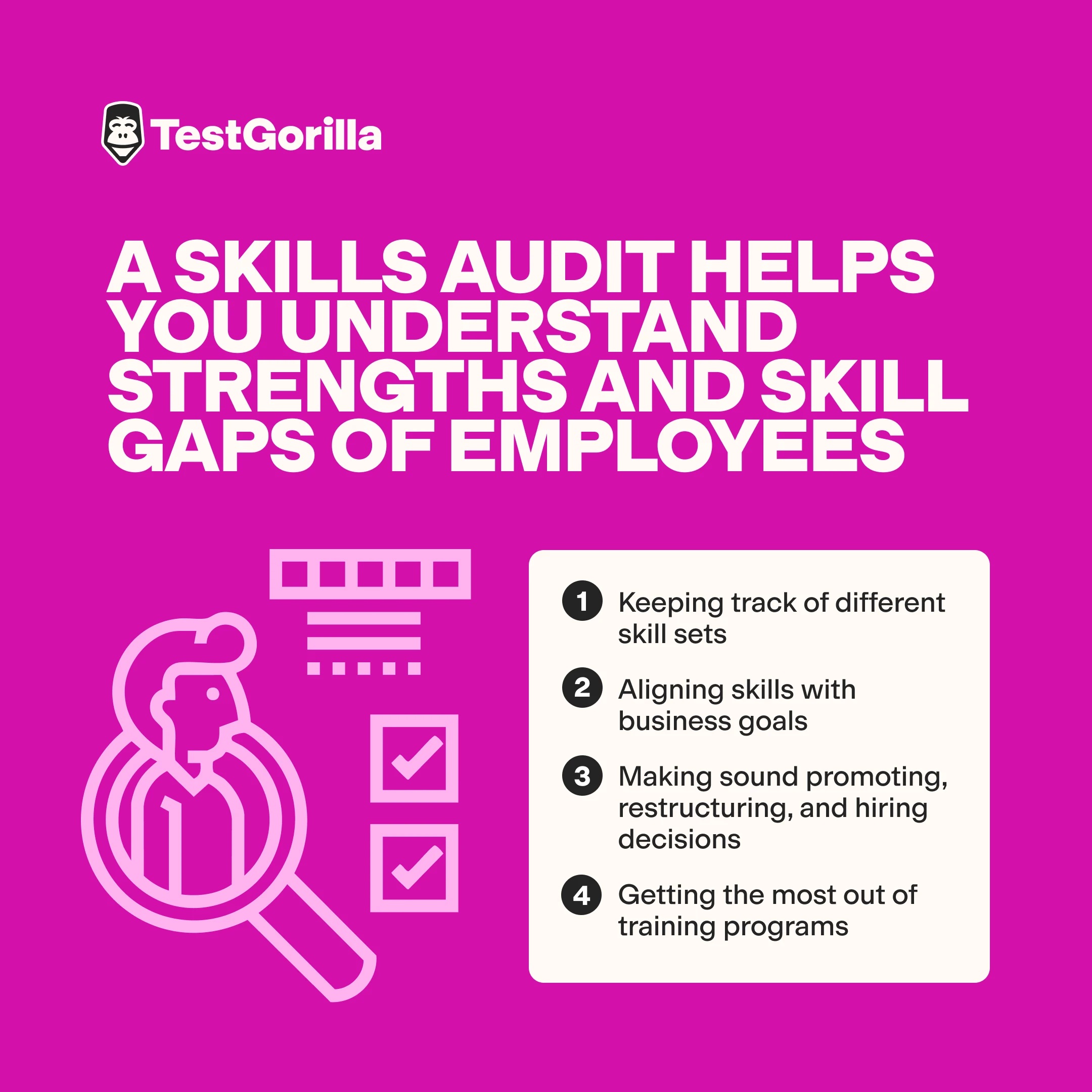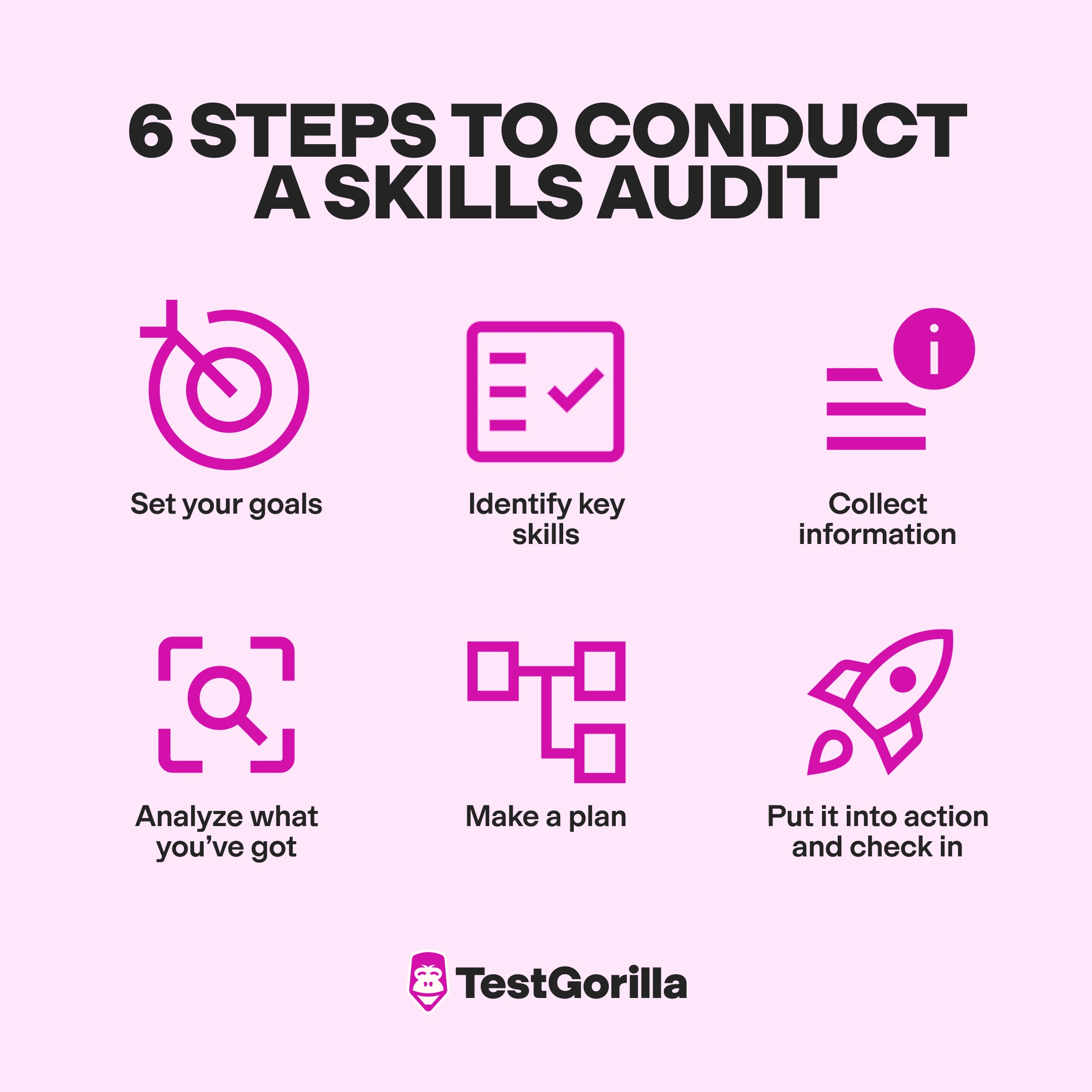What is a skills audit and how do you conduct one?
What is a skills audit?
A skills audit is a process where you evaluate the skills and abilities of your employees through a mix of assessments and feedback.
It typically involves looking at technical skills, soft skills, and other qualities to get a complete picture of each team member’s strengths and areas for improvement. This insight helps businesses make data-driven decisions about employee development, hiring, and team restructuring.
Table of contents
The purpose of a skills audit
The skills audit process is an important part of a broader skills gap analysis. It helps you clearly understand the strengths and skill gaps of each individual employee. You can use this info to make sure your workforce is ready to meet today’s challenges and also equipped for future challenges.
By identifying the skills your team already has and the ones they’ll need, you can build a battle-tested, future-proofed workforce that’s prepared for anything.
Here are some of the common challenges a skills audit helps address.
Keeping track of different skill sets: With so many skills across your team, it’s easy to lose sight of who’s good at what. This makes it harder to make informed decisions about development or hiring.
Aligning skills with business goals: As your company’s goals shift, making sure your team’s skills line up with those goals can be tough. Without this alignment, progress may slow down or head in the wrong direction.
Making sound promoting, restructuring, and hiring decisions: Promotions and role changes shouldn’t be left to guesswork – and neither should hiring. Without clear data, you risk investing time and money in the wrong people.
Getting the most out of training programs: Don’t know where your team needs to improve? That means training efforts can miss the mark. A skills audit helps you target real gaps and get the best return on your training investment.
How a skills audit helps identify both strengths and weaknesses
A successful skills audit looks at the full range of your employees' abilities – technical skills, soft skills, and everything in between. It uses methods like skills-based assessments and manager feedback to reveal where your team shines and where there’s room for improvement.
Let’s look at a few specific examples of how audits can highlight strengths and weaknesses.
What you audit | How you audit | What the audit reveals | How it reveals this |
Your IT team’s ability to use different coding languages | There’s a gap when it comes to Java ⚠️ | By directly testing your team’s Java proficiency | |
Your project team’s leadership skills | Leadership assessments, manager feedback, and self-assessments | A couple employees demonstrate strong leadership abilities | By providing a complete picture of each team member’s leadership potential |
6 steps to conduct a skills audit to future-proof your teams
Follow these six steps for a successful skills audit.
1. Set your goals
Figure out why you’re doing the skills audit. Are you looking to fill gaps for an upcoming project, planning employee training programs, or just getting a better sense of your team’s strengths and weaknesses? Knowing what you’re trying to achieve will guide the whole process.
2. Identify key skills
Next, outline the relevant skills your company needs to meet its goals. This can include technical know-how, soft skills like communication, and any role-specific abilities. Don’t forget about the skills you’ll need as your business grows.
3. Collect information
Gather data on your employees' current skills using a mix of:
Self-assessments: Let employees reflect on and rate their own skills.
Manager feedback: Get input from supervisors on where their team members succeed and fall short.
Competency-based interviews: Dig deeper into how well employee skills match your company’s mission and vision with targeted interviews.
Skills tests: Use these to measure specific abilities, like technical or interpersonal skills.
4. Analyze what you’ve got
To make sense of your skills audit:
Organize the data: Gather the results from tests and assessments in a spreadsheet or skills inventory tool. Label skills by category (e.g., technical, soft, leadership) and the role they apply to. This makes it easier to track patterns.
✨ Pro tip: Use a work competency framework to help categorize and assess the skills needed for each role. This framework defines the specific skills, knowledge, and behaviors required for success in different positions, making it easier to compare actual skills with what's expected.
Spot gaps and strengths: Compare results with the skills your organization needs. Look for areas that need development and hidden strengths – like an employee scoring high in leadership traits who’s not yet in a leadership role. (Note: You’ll dig into this further if and when you move onto a broader skills gap analysis.)
Highlight transferable skills: Identify skills that work across roles, like communication or project management. This helps spot employees who could take on new responsibilities.
Cross-check data: Don’t rely on one type of assessment. Combine the results from various tests to get a full picture of each employee’s strengths and weaknesses.
Visualize findings: Use tools like skills ontologies to map out strengths and gaps, helping you prioritize development efforts.
5. Make a plan
Create a plan to address the gaps and make the most of strengths. This could mean offering training, promoting people into different roles, mentoring, or hiring new talent to cover areas you’re lacking.
For instance, your project manager might have A+ scheduling skills but lack assertiveness in reminding team members about deadlines. If meeting deadlines is a major issue in your organization, this could be an area to focus on for development.
Or, say someone on your team excels at leadership. Consider giving them mentoring opportunities to maximize their impact.
6. Put it into action and check in
Put your plans in motion. Then, keep tabs on how things are going – talk to employees and managers to see if the changes are working. Are gaps closing? Are you capitalizing on strengths?
Since your business needs might shift over time, perform audits regularly and adjust your approach as things evolve.
Check out TestGorilla’s blog for more expert info on hiring, skills, and so much more.
FAQs
Can a skills audit help with employee retention?
Yes, a skills audit can boost employee retention by identifying areas for growth and highlighting strengths. When employees feel their skills are being developed and their potential is recognized, they’re more likely to stay engaged and committed to the company.
How do you handle sensitive findings from a skills audit?
If the audit reveals weaknesses in an employee's performance, use the findings as a basis for offering support and training to help employees grow – rather than criticizing them.
Related posts
You've scrolled this far
Why not try TestGorilla for free, and see what happens when you put skills first.
Latest posts
The best insights on HR and recruitment, delivered to your inbox.
Biweekly updates. No spam. Unsubscribe any time.

Skills tests to hire the best
Our screening tests identify the best candidates and make your hiring decisions faster, easier, and bias-free.
Free resources
A step-by-step blueprint that will help you maximize the benefits of skills-based hiring from faster time-to-hire to improved employee retention.
With our onboarding email templates, you'll reduce first-day jitters, boost confidence, and create a seamless experience for your new hires.
This handbook provides actionable insights, use cases, data, and tools to help you implement skills-based hiring for optimal success
A comprehensive guide packed with detailed strategies, timelines, and best practices — to help you build a seamless onboarding plan.
This in-depth guide includes tools, metrics, and a step-by-step plan for tracking and boosting your recruitment ROI.
Get all the essentials of HR in one place! This cheat sheet covers KPIs, roles, talent acquisition, compliance, performance management, and more to boost your HR expertise.
Onboarding employees can be a challenge. This checklist provides detailed best practices broken down by days, weeks, and months after joining.
Track all the critical calculations that contribute to your recruitment process and find out how to optimize them with this cheat sheet.
















